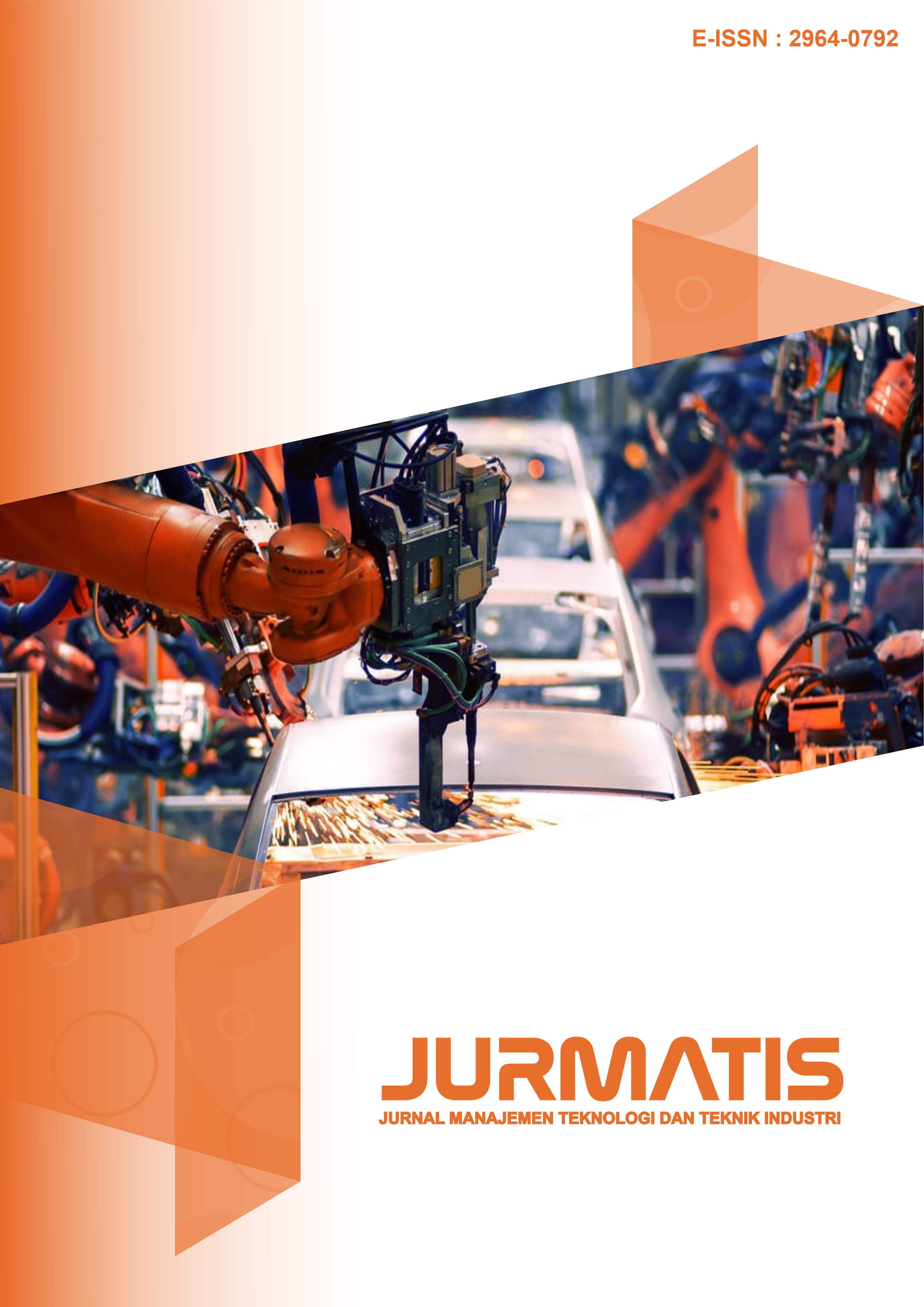Penerapan Metode Life Cycle Assessment Pada Produksi Baja Canai Dingin di PT. XYZ
DOI:
https://doi.org/10.30737/jurmatis.v4i2.2085Keywords:
Environment, Inventory, LCA, Production,Abstract
PT XYZ is a company engaged in the production of cold rolled steel. The purpose of this study is to select materials, calculate the amount of waste produced by cold rolled steel. The method used in this research is Life Cycle Assessment. This method is carried out with the aim and scope of the research, then conducts an inventory analysis followed by an assessment of the resulting impact, ending with providing alternatives to improve the results. Through this LCA analysis, it can be seen that the largest percentage generated from the production process is greenhouse gas emissions  of 5,964  in 2018, 6,216.0 in 2019, and 6,132 in 2020 Then the liquid waste  is 111.51  each year because the use of the volume of water used is fixed at 216,000 L. In addition, there is also acidification produced from the production process with  contributing as much as 57.5  eq in 2018, 59.9 , and 59.1  in 2020.  also contributed to acidification of 29.6  in 2018, 30.8  eq in 2019, and 30.4  eq in 2020. Another method that can be used is the Standard Adesi method, but this method is sought for other types of waste.
Â
PT XYZ adalah sebuah perusahaan yang bergerak di bidang produksi baja canai dingin. Tujuan dari penelitian ini adalah untuk mengevaluasi pemilihan material, menghitung besaran limbah hasil produksi baja canai dingin. Metode yang digunakan dalam penelitian ini adalah Life Cycle Assessment. Metode ini dilakukan dengan menentukan goal and scope dari penelitian, kemudian melakukan inventory analysis yang dilanjutkan dengan penilaian dari dampak yang dihasilkan, yang diakhiri dengan memberikan alternatif guna memperbaiki hasil. Melalui analisis LCA ini dapat diketahui bahwa persentase terbesar yang dihasilkan dari proses produksi tersebut adalah emisi gas rumah kaca  sebesar 5,964  pada tahun 2018, 6,216,0 pada tahun 2019, dan 6,132 pada tahun 2020. Kemudian limbah cair  sebesar 111,51  tiap tahun karena penggunaan volume air yang digunakan tetap yaitu sebesar 216.000 L. Selain itu ada juga asidifikasi yang dihasilkan dari proses produksi tersebut dengan menyumbang sebesar 57,5  pada tahun 2018, 59,9 , dan 59,1  pada tahun 2020.  juga ikut menyumbang asidifikasi sebesar 29,6  pada tahun 2018, 30,8  pada tahun 2019, dan 30,4  pada tahun 2020. Adapun metode lain yang dapat digunakan adalah metode Adesi Standar, namun metode ini diperuntukkan untuk limbah jenis lain.
References
I. Heribertus, B. Santoso, and I. A. Komari, “PERENCANAAN AGREGAT PADA INDUSTRI PENGOLAHAN KAYU JENIS FLOORING DENGAN PENDEKATAN HEURISTIC ( Study Kasus Pada PT Sinar Rimba Pasifik Sidoarjo ) Oleh : Dibimbing Oleh : UNIVERSITAS KADIRI,†JURMATIS J. Ilmial Mhs. Tek. Ind., vol. 1, no. 1, pp. 0–14, 2019.
A. Luthfia, M. S. Abfertiawan, S. Nuraprianisandi, K. Pranoto, P. R. Samban, and A. Elistyandari, “Penggunaan Life Cycle Assessment dalam Penilaian Resiko Dampak Lingkungan dan Pemilihan Alternatif Teknologi di Pertambangan Batubara Indonesia,†2020.
A. W. Daseno, A. Komari, and H. B. Santoso, “Perencanaan Pengelolaan Limbah Kaca Grafir Menjadi Produk Inovasi Baru Guna Menambah Pendapatan Perusahaan (Sudi Kasus Pada UD. Pelangi Art Glass).,†JURMATIS J. Manaj. Teknol. dan Tek. Ind., vol. 3, no. 1, pp. 24-36., 2021.
D. Y. Irawati and D. Andrian, “Analisa Dampak Lingkungan Pada Instalasi Pengolahan Air Minum (IPAM) Dengan Metode Life Cycle Assessment (LCA),†J. Tek. Ind., vol. 19, no. 2, p. 166, 2018, doi: 10.22219/jtiumm.vol19.no2.166-177.
K. A. Pringgajaya and U. Ciptomulyono, “Implementasi Life Cycle Assessment (LCA) dan Pendekatan Analytical Network Process (ANP) untuk Pengembangan Produk Hetric Lamp yang Ramah Lingkungan,†J. Tek. ITS, vol. 1, no. 1, pp. 515–520, 2012.
A. D. Astuti, “Analisis Potensi Dampak Lingkungan Dari Budidaya Tebu Menggunakan Pendektan Life Cycle Assessment (LCA),†J. Litbang, vol. 15, no. 1, pp. 51–64, 2019.
U. Ayuningtyas, M. Yani, and S. Maimunah, “Emisi Gas Rumah Kaca Penggunaan Listrik Pada Kereta Rel Listrik Jaobdetabek Dengan Metode Life Cycle Assessment,†J. Stand., vol. 22, no. 2, pp. 95–106, 2020.
E. Marsillac, I. Zbicinski, and J. Stavenuiter, “Product Design and Life Cycle Assessment,†2011, doi: 10.1057/9780230354890.
R. H. Crawford, “Life Cycle Assessment in the Built Environtment.â€
RIEZQI PRATHAMA HAEDI, “RIEZQI PRATHAMA HAEDI, “KAJIAN PENILAIAN DAUR HIDUP (LIFE CYCLE ASSESSMENT) PADA INDUSTRI FURNITURE (Studi kasus di PT X, Bogor) RIEZQI PRATHAMA HAEDI,†2019.
S. Kholilah, “POTENSI EMISI GAS RUMAH KACA PRODUK TAPIOKA DENGAN PENDEKATAN LIFE CYCLE ASSESSMENT,†2019.
M. Ifdholy, “LIFE CYCLE ASSESSMENT (LCA) PRODUK TEMPE (Studi Kasus: Rumah Tempe Indonesia, Bogor, Jawa Barat),†2018.
J. Wahyudi, “Penerapan Life Cycle Assessment untuk Menakar Emisi Gas Rumah Kaca yang Dihasilkan dari Aktivitas Produksi Tahu,†Urecol, pp. 475–480, 2017.
T. R. Harjanto and S. Bahri, “Life Cycle Assessment pilihan Penggunaan Alat Transportasi Bagi SIswa SMA di CIlacap Dalam Kerangka Penerapan Mekanisme Pembangunan Bersih,†vol. 2, no. 1, pp. 1–13, 2018.
L. C. A. M. Z. Hauschild, “Life Cycle Assessment: Goal and Scope Definition. Berlin: Springer,†2019, doi: 10.1007/978-3-662-53120-4_16860.
A. Arba’i, R. Faridz, and A. A. Jakfar, “Life Cycle Assessment (LCA) Pada Produk Jamu Kunyit Asam di UD. Al Mansyurien Kemal Bangkalan,†Agroindustrial Technol. J., vol. 3, no. 2, pp. 78–94, 2019.
T. R. Harjanto, M. Fahrurrozi, and I. M. Bendiyasa, “Life Cycle Assessment Pabrik Semen PT Holcim Indonesia Tbk. Pabrik Cilacap: Komparasi antara Bahan Bakar Batubara dengan Biomassa,†J. Rekayasa Proses, vol. 6, no. 2, pp. 51–58, 2014, doi: 10.22146/jrekpros.4696.
P. P. Parameswari, Moh. Yani, and A. Ismayana, “Penilaian Daur Hidup (Life Cycle Assesment) Produk Kina Di PT Sinkona Indonesia Lestari,†J. Ilmu Lingkung., vol. 17, no. 2, p. 351, 2019, doi: 10.14710/jil.17.2.351-358.
M. Z. H. and M. A. J. Huijbregts, “Life Cycle Impact Assessment,†Springer, 2015.
R. A. Ula, A. Prasetya, and I. Haryanto, “Life Cycle Assessment (LCA) Pengelolaan Sampah di TPA Gunung Panggung Kabupaten Tuban, Jawa Timur Life Cycle Assessment (LCA) of Municipal Solid Waste Management in Gunung Panggung Landfill, Tuban Regency, East Java,†J. Teknol. Lingkungan, vol. 22, no. 2, pp. 147–161, 2021.
W. A. Fistcar, “Implementasi Life Cycle Assessment (LCA) Pada Pemilihan Perkerasan Kaku dan Lentur Kontruksi Jalan Tol Balikpapan-Samarinda,†J. Apl. Tek. Sipil, vol. 18, no. 2, pp. 307–314, 2020.
Moch. E. A. Bagaswara and Y. Hadi, “Analisis dan Rekayasa Proses Produksi Untuk Mengendalikan Environmental Impact Menggunakan Metode LCA,†J. METRIS, vol. 18, no. 2, pp. 95–104, 2017.
O. Jolliet, M. Saadé-Sbeih, S. Shaked, A. Jolliet, and P. Crettaz, “Environmental Life Cycle Assessment,†Florida CRC Press, 2016.
Downloads
Published
Issue
Section
License
Authors who publish with this journal agree to the following terms:
(1) The copyright of published articles will be transferred to the journal as the publisher of the manuscript. Therefore, the author needs to confirm that the copyright has been managed by the publisher with the Publication Right Form which must be attached when submitting the article.
(2) Publisher of JURMATIS is Kadiri University.
(3) The copyright follows Creative Commons Attribution“ShareAlike License (CC BY SA): This license allows to Share copy and redistribute the material in any medium or format, Adapt remix, transform, and build upon the material, for any purpose, even commercially.



















